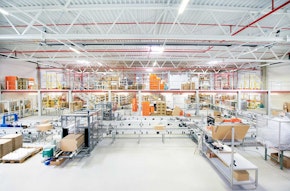Optimise lighting conditions in the warehouse, avoid accidents

Challenge warehouse
The decisive factor for optimum lighting conditions in a warehouse is the height of the hall. It determines which lighting technology is suitable and how it should be installed. Fluorescent lamps are recommended for warehouses up to six metres / 19‘ high. With a height of over six meters / 19‘, high-pressure discharge lamps are a suitable solution. There are special continuous row systems for fluorescent lamps with narrow-beam reflectors, especially for high shelves - these are suitable up fifteen metres / 49‘ light point heights.
You should observe this standard
Especially for areas with high ceilings, make sure to install uniform lighting. This is the only way to avoid dark spots or excessive contrasts between light and dark surfaces - two major accident risks. If the lighting conditions are not on a similar level, it is difficult for the human eye to switch from light to dark immediately. Those short moments in which your employees can’t see properly are sufficient to be the cause of serious accidents. Compliance with the minimum illuminance is therefore an absolute must. This also applies to the regular inspection, cleaning and maintenance of your lighting. If you keep a constant eye on them, accidents can be avoided by inadequate lighting.
According to the currently applicable DIN EN 12464-1:2011-08 for indoor workplace lighting, the minimum illuminance in a warehouse or for storage work is between 50 lux and 200 lux. Experts recommend, however, that luminous intensities of up to 300 lux should be used, especially in warehouses, in order to create optimum lighting conditions and working environments for employees. Because too little light makes you tired and unfocused, which in turn leads to mistakes and accidents.
Risk Factor Interface
There is a high risk of accidents at those points in the warehouse where there is a transition between the interior and exterior areas and between rooms with strong differences in light. The interface between indoor and outdoor areas in particular, with its large differences in brightness, is a source of excessive strain on the human eye. The transition from light to dark is particularly critical - If your employees work in the warehouse during the day and at night, this means moving from the outside to the hall during the day and from the hall to the outside at night.
In order to avoid accidents and adjust lighting conditions, it is advisable to use the different lighting levels with a switchable lighting system for day and night operation.
When it comes to optimum lighting conditions in the warehouse, another factor plays an important role in addition to the accident risk: the cost-effectiveness of your facility. This depends largely on the time your employees need to find and process stored goods. The right light is crucial for this, because the inscriptions on the stored goods and the shelf inscriptions can only be read well if your warehouse has sufficient brightness. It is therefore advisable to place a strong focus on vertical illuminance, especially in a rack storage area.
The optimum light for great heights
Daylight is generally preferable for a pleasant working atmosphere. As natural lighting, it has a positive effect on the well-being and health of employees. This factor can already be taken into account when planning a warehouse: Sufficient window areas, roof-lights or translucent components can produce real wonders in terms of lighting conditions. The ratio of translucent area to room floor area should be 1:10. Bright walls and ceilings can additionally support the effect of daylight and the achievement of optimum lighting conditions. However, daylight lighting is not possible in every warehouse - the keyword is deep-freeze warehouse.
The same applies to facilities with high ceilings. Artificial lighting is a must here. In many cases, it makes sense to install high-bay reflector luminaires with oblique reflectors so that they are in no way inferior to the quality of daylight. These ensure uniform illumination of the entire warehouse. An additional glare shield prevents direct glare to employees when they look up at the shelves. For reading or search tasks, wide-angle or oblique luminaires also help to optimise lighting conditions and make full use of all possibilities for improved visibility. Mobile lighting systems should also be used where the risk of accidents is high.
Individual lighting conditions for individual warehouses
The need for lighting is as varied as the purpose for which a warehouse is used. High halls require a different lighting concept than low ones, shelf warehouses require a different lighting concept than deep-freeze warehouses. Especially for the latter, you should rely on special luminaires specially designed for low temperatures, as the luminous flux of fluorescent lamps decreases sharply with increasing sub-zero temperatures. In order to guarantee optimum lighting conditions, you should therefore rely on suitable technology. This is particularly suitable for damp-proof luminaires.
Light is the decisive factor when it comes to the health, concentration and motivation of your employees. Light helps to increase motivation at work, prevents fatigue and maintains health. The fitter and more attentive your employees are at work in the warehouse, the lower the risk of accidents. Increasing visual comfort also increases people's sense of well-being. This in turn affects the profitability and efficiency of your entire business. In regards to efficiency - make sure you invest in modern lighting technology. Although this is (possibly) more expensive to purchase, it reduces the energy requirements within your entire warehouse. This will save you a lot of money in the long run. Optimum lighting conditions not only reduce the risk of accidents, but also have a positive effect on the overall profitability of your company.